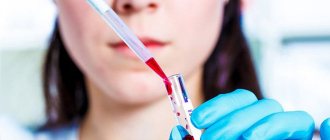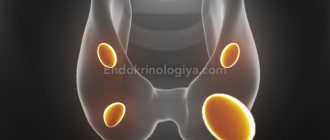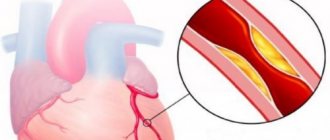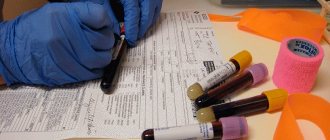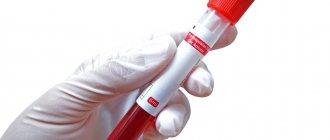Development of anemia in women
Hemoglobin is a protein found in red blood cells. Its main function is to deliver oxygen molecules to tissues and internal organs, remove carbon dioxide and toxic compounds. An indicator of 117–120 g/l in middle-aged women is considered normal for life support. But for various reasons, a violation of healthy levels occurs:
- diseases of the urinary system;
- hidden bleeding;
- malignant neoplasms;
- strict diets or fasting;
- monthly menstruation;
- blood loss due to injury;
- bone marrow pathologies.
Anemia in women occurs due to problems with hematopoiesis and impaired iron-binding ability of the blood. Hemoglobin drops during pregnancy, after childbirth or major surgery. Depending on the severity, there are several stages of the disease:
- Easy. It is characterized by a drop to 90 g/l, does not require hospitalization, and is easily corrected by changing the diet.
- Average. Hemoglobin drops to 70 g/l, health problems and exacerbation of chronic diseases are observed.
- Heavy. The indicator drops below 70 g/l, the patient requires drug treatment in a hospital.
The main signs of anemia in women that require additional diagnostics:
- chronic fatigue, irritability, muscle weakness;
- low-grade fever not higher than 37.3° C for a long time;
- tachycardia;
- frequent ARVI;
- dizziness;
- pressure changes.
The lower the hemoglobin level, the more severe the symptoms. With chronic anemia, women experience pale and bluish skin, shortness of breath when walking or climbing stairs. In 90% of patients, low blood pressure and digestive problems are detected.
Important! During menstruation, hemoglobin levels can drop sharply by 30 units. But with proper nutrition and the absence of chronic diseases, it recovers within 7–10 days without consequences.
Is it dangerous to exceed the norm?
In some pathologies, the body begins to intensively produce hemoglobin. If the norm is significantly exceeded, the composition of the blood changes and the risk of blood clots increases. This is fraught with blockage of veins, impaired circulation in the extremities, and often causes cardiac ischemia or cerebral stroke. Possible reasons include:
- diabetes;
- pathologies of the thyroid gland;
- intestinal obstruction.
For women, a hemoglobin level above 150 g/l is considered dangerous. A disorder can be suspected by characteristic symptoms: high blood pressure, pale skin on the fingertips, frequent urination, joint pain.
How to get tested
To get a reliable hemoglobin result, you must follow some rules before donating blood:
- Do not take medications, iron, vitamin preparations, or dietary supplements 3-5 days before the planned date of testing.
- Limit intake of fatty foods and alcohol the day before the examination.
- One hour before the examination, you should not smoke or have physical or emotional stress.
Any level deviations are a sign of health problems. At high numbers, the blood becomes thickened, which causes blood clots to form in the blood vessels and increases the risk of developing critical conditions.
According to observations, low hemoglobin levels are more common in women, and increased levels are more common in men.
A low level of hemoglobin, which persists for about three months, already leads to the development of hypoxia (oxygen starvation) of organs and systems and inhibition of their functions.
Iron deficiency anemia during pregnancy
When carrying a child, a woman's body undergoes hormonal changes and the total blood volume increases. Doctors calculated what level of hemoglobin is considered critical for the expectant mother:
- mild anemia with a reading from 90 to 110 g/l;
- average at 80–90 g/l;
- heavy – below 80 g/l.
At risk are women with multiple pregnancies, patients with severe toxicosis or kidney disease. The interval between previous births and conception of less than 2 years increases the risk of anemia.
The main danger of critically low hemoglobin during pregnancy is disruption of embryo development. The child’s brain and nervous system experience oxygen starvation and lack of nutrients. There is a risk of congenital pathologies and anomalies, cerebral palsy. Therefore, gynecologists do not recommend refusing regular tests, offer vitamin complexes, and prohibit strict diets unless necessary.
How to normalize hemoglobin levels
Hemoglobin levels can be adjusted not only with medications, but also with a certain diet. You can increase low hemoglobin by eating foods rich in protein and iron.
Don't give up meat, chicken and liver. Large amounts of iron can be found in foods such as pomegranate, buckwheat or apples.
Eating parsley, walnuts, spinach, persimmons, honey, etc. also has a beneficial effect on hemoglobin.
A balanced diet should be combined with moderate physical activity, good sleep and adequate oxygen. Syrups or tablets with a high iron content are used as medicines. In some cases, injections are prescribed.
If your hemoglobin level is elevated, the best solution would be to avoid red foods. These include meat, tomatoes, pomegranate, apples, carrots, etc.
It is also necessary to limit the consumption of fruits. An exception may be citrus fruits, and in particular lemon.
Shilajit copes very well with increased hemoglobin. As for cereals, you should limit yourself to oats and pearl barley. The diet should also include legumes and dairy products. Fasting days are recommended for patients with elevated hemoglobin. You need to arrange them at least once a week. Another good way to lower hemoglobin is leeches.
However, such therapy should be agreed with the attending physician. In rare cases, the patient is prescribed blood transfusions . But most often a number of specialized medications are prescribed. The most common are Cardiomagnyl and Trental.
Deviations from the norm in men
In representatives of the stronger sex, the critical hemoglobin in the blood begins at 70 g/l. To maintain health and well-being, a man needs to keep it at a level of 130 g/l. Deviation from the norm is possible in several situations:
- smoking;
- accommodation in mountainous areas;
- chronic diseases;
- oncology;
- hard physical labor;
- taking steroids while playing sports.
Violations of the indicator are sometimes diagnosed when working in polluted conditions or constant contact with chemicals or dyes. In men after 50 years of age, hemoglobin decreases due to decreased metabolism and decreased production of red blood cells due to the aging of the body.
Important! According to doctors' observations, some men over 30 years of age experience a sharp drop in hemoglobin during sleep.
After waking up, it returns to normal within 1–2 hours, but this fact must be taken into account when taking tests.
What to do if hemoglobin is 70: how to raise the level to normal
From this article you will learn: how and why anemia occurs, what ways to treat it, and what level of hemoglobin is considered critical.
Anemia or anemia occurs when the number of red blood cells decreases. In a blood test, this indicator is expressed as the concentration of hemoglobin, an iron-containing pigment that gives red blood cells their red color.
In some cases, anemia can be a symptom of other diseases: cancer, internal bleeding, pathologies of the hematopoietic system and gastrointestinal tract. Therefore, a decrease in hemoglobin cannot be ignored. Determining the cause and treatment is necessary if the indicator deviates by more than 5 g/l.
Hemoglobin norms in the blood of a healthy person
Hemoglobin is a variable quantity, its concentration varies according to the age and gender of a person.
Hemoglobin norms for healthy people are presented in the table.
Causes of anemia
- The body received a sufficient amount of iron;
- The gastrointestinal tract must ensure normal absorption of iron;
- Vitamin C, which improves iron absorption, and vitamins B9 and B12, which are involved in the synthesis of hemoglobin, should be supplied with food;
- There were no disorders of the kidneys, hematopoietic system or cardiovascular system.
Based on these conditions, it is possible to determine the range of causes of anemia. In 80% of cases, anemia is caused by iron deficiency, this is due to insufficient intake of iron into the body from food or an increased need for a microelement.
Among other problems that can provoke deficiency anemia, the most common are:
- Lack of B vitamins;
- Disturbances in the gastrointestinal tract, as a result of which iron is not absorbed;
- Increased physical activity (in athletes);
- Donation.
There are other forms of anemia that are caused by serious pathologies:
- Blood loss (open and closed bleeding) is the cause of posthemorrhagic anemia;
- The presence of cancer is the cause of posthemorrhagic and hemolytic anemia;
- Pathologies of the hematopoietic system are the cause of hypoplastic and aplastic anemia.
Important! The drug Hemobin will help replenish the lack of iron in the body. Thanks to its natural composition, it can be used to treat anemia even in children and pregnant women.
Degrees of anemia
Mild degree
The course is practically asymptomatic. Sometimes weakness, fatigue, loss of appetite and pale skin are possible.
Average degree
If hemoglobin is 80 or lower, how to increase the level? Treatment of moderate anemia is determined by its cause:
Hemoglobin level is 70, how to increase it? This value is conditionally considered critical. In this case, urgent medical attention and further correction of the resulting deficiency of iron and vitamins are necessary.
Severe degree
If a blood test shows hemoglobin 70, how to raise it must be decided urgently. The first thing the attending physician should do is to identify the cause and eliminate it. Then long-term use of iron supplements is prescribed to replenish the lack of iron reserves in the body.
Symptoms of severe anemia:
- Brittle hair and nails, deterioration of their condition;
- Chills;
- Feeling of numbness in the limbs;
- Change in taste habits;
- Increased size of the liver and spleen.
These drugs can be replaced with Hemobin. Its composition is unique - it contains only natural ingredients. Namely, similar in structure and structure to human hemoglobin, purified hemoglobin from farm animals and vitamin C, which improves the absorption of iron. Heme iron is divalent. It is in this form that iron is absorbed in the human body. It has high bioavailability (almost 100% of iron is absorbed).
Treatment of anemia with hemobin:
Children 7-14 years old: 2 tablets 3 times a day; Adults: 2-4 tablets 3 times daily
Today you learned: why anemia occurs, how it manifests itself and what to do if hemoglobin drops below normal.
Recommended Articles
Hemoglobin treats cardiovascular diseases
Hemobin for radiation victims
Information certificate on hemoglobin-containing waste from blood processing.
Hemobin in contaminated areas
Iron deficiency in military personnel
Development of iron deficiency and anemia.
1996 — LLC NPF MOBITEK-M
Reprinting materials without approval is permitted if there is a dofollow link to the source page.
Company LLC NPF MOBITEK-M
Kaluga region, Borovsk. OGRN: 1024000534777
Low hemoglobin in childhood
A critical level of hemoglobin in a child’s blood is often diagnosed during adolescence. At the age of 11–13 years, active restructuring and sharp surges in hormones begin, affecting basic life processes. The second reason is the adolescent’s poor nutrition: it is difficult for parents to control school snacks and lunches; children overeat fast food and snacks, and refuse soups and vegetables.
The first blood test for hemoglobin level is done to the baby after birth. Doctors try to control the indicator in order to prevent oxygen starvation of organs and systems. Normally, it is 150–190 g/l in the first 2 weeks, quickly decreasing to the parameters of an adult. Anemia in children occurs for the following reasons:
- congenital pathologies of the hematopoietic system;
- untimely introduction of complementary foods;
- vegetarian diet at the request of parents;
- maternal anemia during pregnancy.
In the future, doctors recommend taking blood tests annually to monitor hemoglobin levels as the child grows. Its fall may indicate hemophilia, vitamin deficiency, allergies or helminthic infestations.
Rules for taking a hemoglobin test
As we have now found out, a hemoglobin test allows us to find out the amount of iron-containing protein in the circulatory system over the past three months. No special preliminary preparation is required. However, it is important to perform this procedure early in the morning and preferably on an empty stomach. Moreover, the last meal should be at least eight hours ago.
Do you donate blood for hemoglobin on an empty stomach or not? This question worries many pregnant women, who may simply faint on an empty stomach. In this case, you can and even need to take something to eat with you after the procedure. Chocolate will be the best option so that your health does not deteriorate and strength is not lost.
At the same time, a week before the procedure, you must stop taking medications. However, if this is not possible, you should discuss this issue with your doctor. Also, on the eve of the analysis, it is imperative to refrain from eating fatty foods and junk food. Also, try to avoid strenuous physical activity and remain calm.
What level is considered lethal?
Experts believe that the lethal level of hemoglobin for an adult is below 70 g/l. In fact, the patient dies not from a lack of protein, but from the development of complications due to oxygen starvation:
- metabolic disease;
- drop in immune defense;
- exacerbation of chronic diseases of the kidneys, liver, intestinal tract;
- severe arrhythmia or tachycardia.
With acute and massive blood loss and a drop in hemoglobin below 38 g/l, the patient dies from cerebral hypoxia. But with a slow decrease in iron-containing protein, symptoms appear gradually, the body adapts to the changes. Therefore, in medical practice there are many cases where a person with anemia at a level of 40–50 g/l works productively and leads a relatively active lifestyle. This is due to the individual characteristics of the patient’s cardiovascular and nervous system, his age and health.
Prevention of anemia
It is necessary to monitor hemoglobin levels constantly and at any age. The well-being and performance of a person depend on the value of the indicator, so the danger of pathology should not be underestimated. To avoid anemia, it is important to remember the rules of prevention:
- proper and balanced nutrition;
- reducing portions of coffee and alcohol;
- physical activity;
- compliance with the drinking regime.
To fully absorb iron from food, it is necessary to consume meat products at the same time as greens and vegetables. A large amount of the beneficial element is found in liver, pork and mushrooms, legumes, oatmeal and corn grits, and offal. Instead of sweets, it is better to lean on dried fruits and cashew nuts, hazelnuts, and fresh blueberries. Folic acid and B vitamins strengthen the binding in the molecule and stimulate the production of hemoglobin.
During pregnancy, diet or toxicosis, it is necessary to take complex vitamins. They should be selected by a specialist based on tests and after examining the patient. Doctors do not recommend raising hemoglobin with drugs containing high iron content without medical indications. With proper nutrition, the indicator increases in 20–25 days to normal levels.
Important! To prevent anemia, nutrition should be varied at all times. For example, during fasting or a vegetarian diet, meat is replaced with dried mushrooms and legumes, desserts are prepared from honey with nuts, and beet salads.
A critical hemoglobin level often develops gradually and without significant symptoms. In this case, irreversible disturbances in the functioning of organs and systems occur, which have to be treated in a hospital for a long time. Therefore, it is necessary to promptly identify and eliminate the cause, and not neglect preventive measures and doctor’s recommendations.
Hemoglobin and pregnancy
Monitoring hemoglobin levels in pregnant women is especially important, since deviations to a lesser or greater extent can have serious consequences. Moreover, this applies not only to the course of the pregnancy itself, but also to the child. Normally, the protein level is between 12-14 units.
Those who want to know how to properly donate blood for glycated hemoglobin should consider one important point. Deviations may be insignificant, which can also be regarded as the norm, since in most cases they are short-lived. In the female body of a pregnant woman, hemoglobin, in addition to normalizing blood flow between internal organs, forms a connection with the placenta, through which the child receives the necessary amount of oxygen.
When blood protein levels are low, graying symptoms are felt:
In most cases, hemoglobin levels in pregnant women decrease after the 20th week. At the same time, this negatively affects the development of the child - first of all, his growth slows down, even in the womb his immunity is greatly undermined, and the metabolic process worsens. Therefore, many women are concerned about how to properly donate blood for hemoglobin.
It is more likely that the child will subsequently be born with low birth weight, and will also be seriously behind his peers in development. In addition, complications cannot be avoided during the birth of a child. Due to the low hemoglobin content, labor activity slows down significantly. There may also be heavy bleeding.



